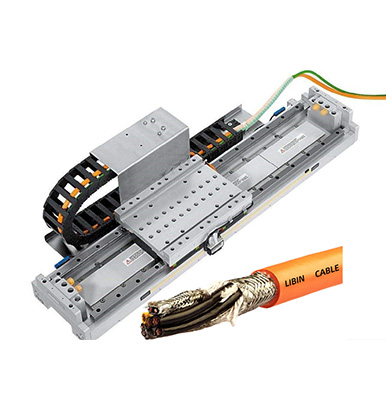A Drag Chain Cable, also known as an energy chain cable or cable carrier cable, is a specially designed electrical cable used in dynamic applications where constant movement, bending, and high mechanical stress occur. Unlike standard cables, drag chain cables are built for durability, flexibility, and reliability under repetitive motion.
These cables are essential in industries such as:
CNC machinery
Automation systems
Robotics
Packaging equipment
Heavy-duty material handling
By using drag chain cables, companies reduce downtime, extend equipment life, and improve safety in demanding environments.
The design of drag chain cables ensures long-lasting performance in moving applications. Below is a breakdown of their main components:
Usually made of extra-fine stranded copper wires for flexibility.
Ensures excellent electrical conductivity.
Made from PVC, TPE, or PUR materials.
Provides high electrical resistance and temperature stability.
Tinned copper braid or foil shielding.
Protects against EMI/RFI interference in data or control lines.
Abrasion-resistant, oil-resistant, and flame-retardant materials.
Designed to withstand harsh industrial environments.
| Component | Material Options | Function |
|---|---|---|
| Conductor | Fine stranded copper | High flexibility & conductivity |
| Insulation | PVC, TPE, PUR | Electrical insulation, heat resistance |
| Shielding | Copper braid, foil | EMI/RFI protection |
| Outer Jacket | PUR, PVC | Mechanical & chemical resistance |
To ensure maximum cable lifespan and performance, proper installation conditions must be met.
Maintain a minimum bending radius of 7.5 to 10 times the outer cable diameter.
Prevents excessive stress on conductors.
Install cables loosely side by side.
Avoid crossing or twisting inside the drag chain.
Leave sufficient cable length for free movement during motion.
Prevents tension and stretching.
Select cable jackets according to conditions:
Oil-resistant for machine tools.
UV-resistant for outdoor use.
Flame-retardant for safety-critical areas.
Drag chain cables are widely recognized by global users for their performance. Based on user feedback, here are the most common benefits:
Extended Service Life: Customers report a lifespan 3–5 times longer than traditional cables in moving applications.
Reduced Downtime: Less frequent cable replacement saves maintenance costs.
Smooth Machine Operation: Stable transmission of power and signals ensures precision.
High Safety Standards: Compliance with UL, CE, and RoHS certifications provides confidence in quality.
Versatility: Suitable for industries ranging from robotics to heavy machinery.
Example feedback:
“After switching to drag chain cables, our CNC machines experienced zero cable failures over 18 months.”
“The flexibility of PUR-jacket drag chain cables greatly reduced maintenance in our automation lines.”

To guarantee reliability, manufacturers implement strict quality control processes.
Raw Material Testing
Conductivity test for copper wires.
Mechanical strength verification of insulation and jacket materials.
Flexibility and Bending Tests
Cables tested for millions of bending cycles under load.
Ensures durability in repetitive motion.
Electrical Testing
Resistance, capacitance, and insulation strength measurements.
Detects any defects before shipment.
Environmental Resistance Checks
Oil resistance, chemical resistance, and UV stability tests.
Flame-retardancy and low smoke tests for safety compliance.
Final Inspection
Visual inspection for defects.
Certification labeling and documentation for traceability.
| Test Type | Purpose | Standard Reference |
|---|---|---|
| Conductor Resistance Test | Ensures electrical efficiency | IEC 60228 |
| Bending Cycle Test | Verifies durability in motion | ≥ 5 million cycles |
| Insulation Breakdown Test | Safety against electrical faults | IEC 60332 |
| Flame Retardancy Test | Prevents fire hazards | UL 1581, IEC 60332-1 |
When selecting drag chain cables, consider:
Application type: Power, control, or data transmission.
Motion speed & acceleration: Higher speed requires stronger cable design.
Operating environment: Exposure to oil, chemicals, or outdoor conditions.
Certifications required: CE, UL, RoHS, or other industry standards.
A Drag Chain Cable is not just a cable—it is a key component for industrial reliability. With proper installation, high-quality materials, and strict quality control, drag chain cables ensure long-term performance in automation, robotics, and heavy machinery.
Whether your business focuses on CNC machining, industrial automation, or high-speed production lines, choosing the right drag chain cable can dramatically reduce downtime, lower maintenance costs, and improve overall efficiency.
For bulk supply, OEM customization, or technical consultation, partnering with a reliable drag chain cable manufacturer is the best step toward building a more efficient and competitive industrial system.
 RELATED
RELATED
 RELATED
RELATED
این وب سایت از کوکی ها استفاده می کند تا اطمینان حاصل شود که بهترین تجربه را در وب سایت ما به دست می آورید.